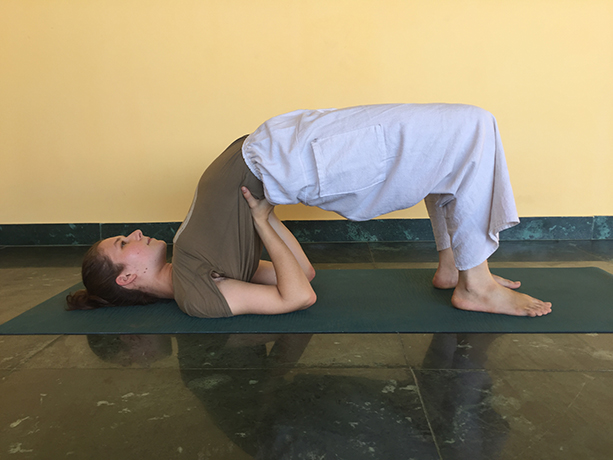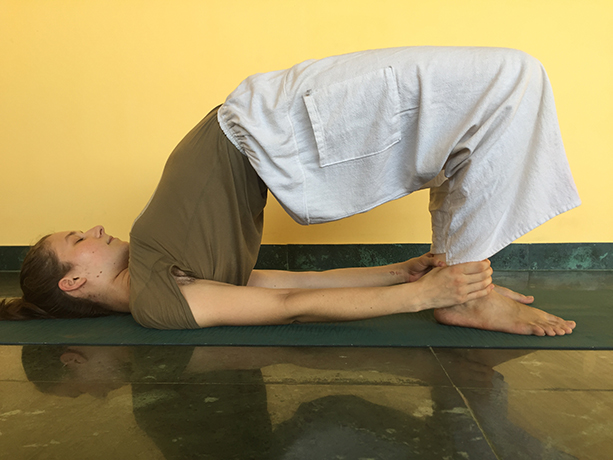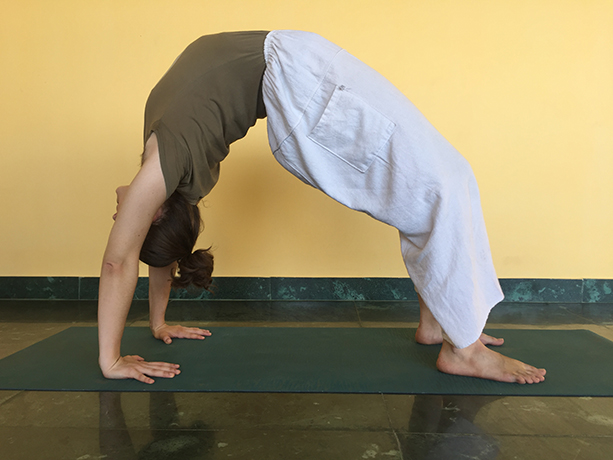This is a backbend variation sequence featuring the Bridge (Setu-Bandhasana), Half-Wheel (Ardha-Chakrasana) and Full Wheel (Chakrasana). It is usually practiced directly after Halasana, as a counterposture. This is a very common sequence in the Open Class so we thought it was a good place to start teaching the variations.
Practice only as much as your body allows, do not move on to the next posture until you are comfortable. If you are new or have limited mobility practicing the bridge is enough.
Benefits:
- Counter-stretch for the Plough
- Improves spinal flexibility in thoracic and lumbar regions
- Strengthens abdominal and lumbar muscles
- Promotes wrist flexibility and mobility (Setu-Bandhasana)
- Chakrasana improves upper back, shoulder and arm strength and flexibility
Instructions:

Setu-Bandhasana
1. Start by laying on the back, arms by the sides, palms flat on the ground*.
2. Bend the knees, place the feet on the ground.
3. Lift the hips up and place the hands on the lower back the same way as you hold the Shoulderstand. Squeeze the buttocks to lift the hips higher. Alternatively, interlace the fingers and place the hands on the mat pressing down. Breathe deeply. As you get more comfortable in the posture squeeze the knees together.
* You may also come into this position directly from Sarvangasana by scissoring the legs. To practice this transition you bring one foot over the head, bend the opposite knee and bring that foot to the ground slowly. At first this is a little confusing because you cannot tell how far away from the ground the foot is, but after you practice a few times it will seem natural. Do not change the hand position. If you have never tried this transition and have any doubt, please find a teacher to guide you. Om Shanti
Ardha-Chakrasana
4. Walk the feet closer to the hands and hold the ankles. Keep pushing the hips up.
Chakrasana
5. Place the hands under the shoulders, elbows pointed up to the ceiling.
6. Press into the arms and lift the upper body off the ground.
7. Straighten the arms as much as possible. Continue to breathe deeply. Keep the head between the arms.
8. To come out of the posture, bend the elbows, gently lower the upper back to the ground and slowly release. For a counter posture(for all three asanas), hug the knees into the chest. Inhale, lift the forehead to the knees, exhale, release. Relax in Savasana.
Tips:
- In Chakrasana, push through the legs and try to straighten them. This will deepen the stretch in the shoulders. Make sure the arms are straight.
- If you are very strong and flexible, you can begin to walk the hands and feet together. Don’t rush, go slow and be gentle with your body.
- In all three positions, if there is any lower back pain come out immediately. If you don’t normally have lower back pain, sometimes if the knees are too far apart the lower back over arches and causes discomfort. The next time you practice try bringing the knees closer together to protect the lower back.





